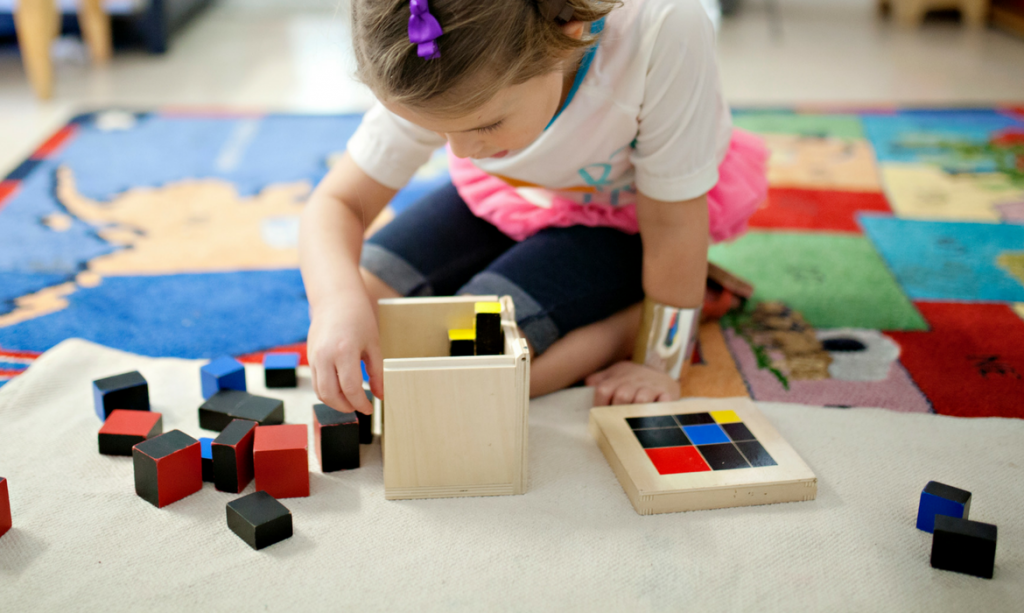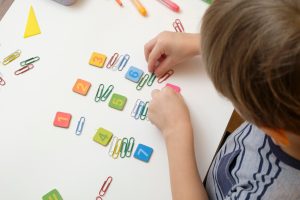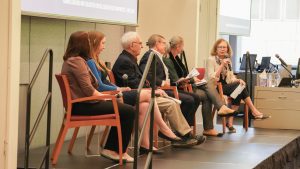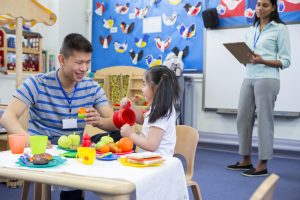Let’s stop the cycle of “abuse”–or at least confusion–that stems from harsh disagreements in early education. Play or academics is arguably a main one. Of course children should play. But this does not mean they should not learn, and even play with, mathematics. These five research findings show that play versus academics is a false dichotomy.
- In their free play, children naturally engage in mathematics. [1] Observations of preschoolers show that when they play, they engage in mathematical thinking at least once in almost half of each minute that they are playing. Almost 9 in 10 children engage in one or more math activities during play episodes. [2] That’s a lot of child-centered, child-generated mathematics!
- This mathematical play reveals intuitive knowledge of ideas that most people think young children cannot understand, from arithmetic to proportions to right angles. Unfortunately, these same children may not “understand” these concepts when they arrive in middle school. If they are not helped to mathematize (reflect on, give language to–more later) these early “theorems in action” [3], the ideas do not become theorems in thought. Children love learning the language of mathematics–let’s give them that gift as they build their insights into number, geometry, measurement, and patterning.
- Many adults, including early educators, believe that sequenced, intentional instruction will harm children’s play. These concerns are misplaced. Math and literacy instruction increase the quality of young children’s play. Children in classrooms with stronger emphasis on literacy or math are more likely to engage at a higher quality of social-dramatic play. [4] The new ideas energize high-level play activity. Thus, high-quality instruction in math and high-quality free play do not have to “compete” for time in the classroom. Doing both makes each richer. Unfortunately, many adults believe that “open-ended free play” is good and “lessons” in math are not. [5, 6] They do not believe that preschoolers need specific math teaching. [7] They do not realize that they are depriving children of the joy and fascination of mathematics, as well as of higher-quality free play.
- If children play with mathematical objects before they are asked to solve problems with them, they are more successful and more creative. [8, 9] Young children can be creative mathematicians.
- These and other examples bring us to a fascinating type of play: mathematical play. Here we do not mean play that involves mathematics. We mean playing with mathematics itself.
Playing with Mathematics
Let’s look at an example. Just after her fourth birthday, Abby is playing with three of the five identical toy train engines her father had brought home. Passing by, her mother asks, “Where are the other trains?” With her mother now out of sight, Abby speaks to herself. “Oh, I have five. Ummm . . . [pointing to each engine] You are one, two, three. I’m missing four and five–two are missing!” She plays with the trains for another minute. “No, I changed my mind. I have one, three, and five. I’m missing two and four. I gotta find them two.”
When Abby first figured out how many she was missing, she was using math in her play. But when she decided that she would renumber the three engines she had “one,” “three,” and “five,” and the missing engines “two” and “four,” she was playing with the notion that the assignment of numbers to a collection of objects is arbitrary. She was also counting not just objects, but also counting words. She counted the words “four and five” to see that there were two missing, and then figured out that counting the renumbered counting words “two” and “four” also yielded the result of two missing. She was playing with the idea that counting words themselves could be counted. [10]
Foundational and Mathematized Experiences
What does all this mean regarding children’s development and learning? Free play experiences form the intuitive, implicit conceptual foundation for later mathematics (as well as all domains!). Later, children represent and elaborate these ideas–creating models of an everyday activity with mathematical objects, such as numbers and shapes, as well as mathematical actions, such as counting or transforming shapes. This is the process of mathematization. [11] Recognizing the difference between foundational and mathematized experiences is necessary to avoid confusion about the type of activity in which children are engaged. [12] Children need both.
Powerful Pedagogy: Mathematizing Play
Unfortunately, adults often do not provide the mathematized experiences. [13] Many times, working with teachers on our own curricula has been stonewalled by an adminstrator saying, “Our philosophy is that we are play-based.” Not only does this statement ignore all the evidence on play and learning [e.g., 10], it is based on a pernicious false dichotomy that harms the children in their care.
In summary, young children engage in significant mathematical thinking and reasoning in their play, especially if (a) they have knowledge about the materials they are using (e.g., building blocks or other manipulatives or toys), (b) the task is understandable and motivating, and (c) the context is familiar and comfortable. [14] Math can be integrated with children’s ongoing play and activities, but this integration usually requires a curriculum and a knowledgeable adult who creates a supportive environment and provides challenges, suggestions, tasks, and language. Combining free play with intentional teaching, and promoting play with mathematical objects and mathematical ideas is pedagogically powerful. [15, 16]
This blog is adapted slightly from that originally published by the National Institute for Early Education Research (NIEER).
[1] van Oers, B. (1996). Are you sure? Stimulating mathematical thinking during young children’s play. European Early Childhood Education Research Journal, 4, 71-87.
[2] Seo, K.-H., & Ginsburg, H. P. (2004). What is developmentally appropriate in early childhood mathematics education? In D. H. Clements, J. Sarama, & A.-M. DiBiase (Eds.), Engaging young children in mathematics: Standards for early childhood mathematics education (pp. 91-104). Mahwah, NJ: Erlbaum.
[3] Vergnaud, G. (1978). The acquisition of arithmetical concepts. In E. Cohors-Fresenborg & I. Wachsmuth (Eds.), Proceedings of the 2nd Conference of the International Group for the Psychology of Mathematics Education (pp. 344-355). Osnabruck, Germany.
[4] Aydogan, C., Plummer, C., Kang, S. J., Bilbrey, C., Farran, D.C., & Lipsey, M. W. (2005, April). An investigation of prekindergarten curricula: Influences on classroom characteristics and child engagement. Paper presented at the NAEYC, Washington, DC.
[5] Sarama, J. (2002). Listening to teachers: Planning for professional development. Teaching Children Mathematics, 9, 36-39.
[6] Sarama, J., & DiBiase, A.-M. (2004). The professional development challenge in preschool mathematics. In D. H. Clements, J. Sarama, & A.-M. DiBiase (Eds.), Engaging young children in mathematics: Standards for early childhood mathematics aducation (pp. 415-446). Mahwah, NJ: Erlbaum.
[7] Clements, D. H., & Sarama, J. (2009). Learning and teaching early math: The learning trajectories approach. New York, NY: Routledge.
[8] Bruner, J., (1985). On teaching thinking: An afterthought. In S. F. Chipman, J. W. Segal, & R. Glaser (Eds.), Thinking and learning skills. Volume 2: Research and open questions (Vol. 2, pp. 597-608). Hillsdale, NJ: Erlbaum.
[9] Holton, D., Ahmed, A., Williams, H., & Hill, C. (2001). On the importance of mathematical play. International Journal of Mathematical Education in Science and Technology, 32, 401-415.
[10] Sarama, J., & Clements, D. H. (2009a). Building blocks and cognitive building blocks: Playing to know the world mathematically. American Journal of Play, 1, 313-337.
[11] Sarama, J., & Clements, D. H. (2009b). Early childhood mathematics education research: Learning trajectories for young children. New York, NY: Routledge.
[12] Kronholz, J. (2000, May 16). See Johnny jump! Hey, isn’t it math he’s really doing?, The Wall Street Journal, p. A1; A12.
[13] Tudge, J. R. H., & Doucet, F. (2004). Early mathematical experiences: Observing young Black and White children’s everyday activities. Early Childhood Research Quarterly, 19, 21-39.
[14] Alexander, P. A., White, C. S., & Daugherty, M. (1997). Analogical reasoning and early mathematics learning. In L. D. English (ed.), Mathematical reasoning: Analogies, metaphors, and images (pp. 117-147). Mahwah, NJ: Erlbaum.
[15] Clements, D. H., & Sarama, J. (2005a). Math play. Parent & Child, 12 (4), 36-45.
[16] Clements, D. H., & Sarama, J. (2005b). Math play: How young children approach math. Early Childhood Today, 19 (4), 50-57.



